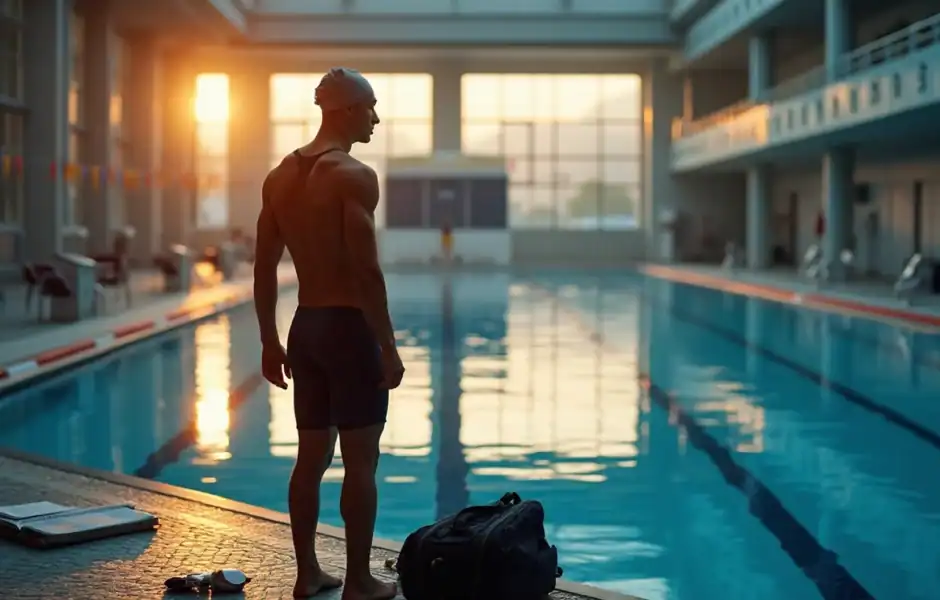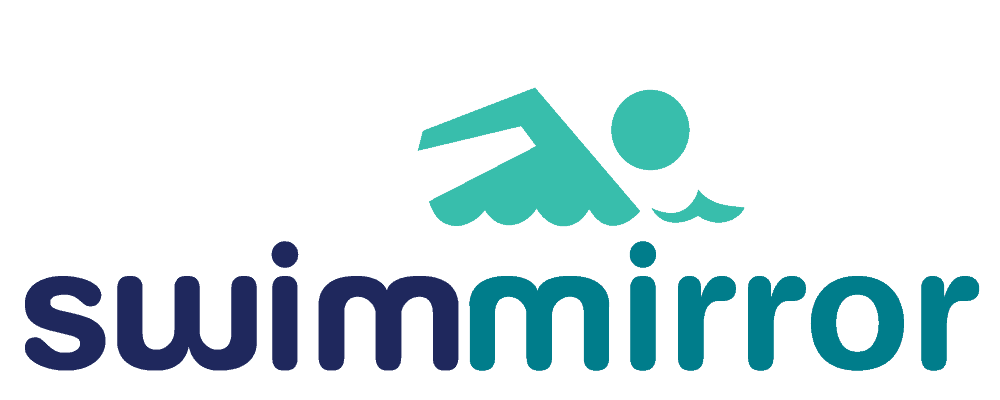11 Daily Habits Of Competitive Swimmers That Build Champions

Competitive swimmers dedicate an astonishing 4 to 6 hours to training daily, often split into two separate sessions, six days a week. This level of commitment isn’t just about talent—it’s about developing championship-level habits that transform good athletes into great ones.
Since 1896, swimming has been featured in the Olympic Games, highlighting its status as one of the world’s most beloved competitive sports. What is competitive swimming if not a demonstration of extraordinary discipline? Elite swimmers significantly outperform their counterparts with 62.5% propelling efficiency compared to 45.6% for triathlon swimmers. The difference between champions and others isn’t just natural ability—it’s the daily habits that shape a competitive swimmer’s body and mind. These habits involve structured swimming sets for competitive swimmers, proper nutrition to fuel the professional swimmer’s body, and mental conditioning techniques to excel when swimming competitively.
Ultimately, the journey to becoming an elite athlete involves both physical training and mental fortitude. The first swimming championship held in Australia in 1846 marked the beginning of a sport that would demand extraordinary sacrifice and dedication. Here are 11 daily habits that separate those who swim competitive from those who dominate the sport.
Start the Day with Purpose
Elite swimmers know that championship performances begin long before they dive into the competition pool. The morning hours offer a crucial opportunity to set intentions and build mental fortitude that carries throughout the day.
Start the Day with Purpose mindset
The champion’s mindset begins with waking up early—often before sunrise. Many competitive swimmers rise before dawn to train while the world sleeps. This early start isn’t merely about logging extra yards; it’s about mental conditioning. Top swimmers understand that conquering the comfort of warm sheets teaches discipline that transfers to pushing through tough sets later in the day.
Visualization plays a pivotal role in morning mental preparation. Many Olympic-level athletes spend 5-10 minutes each morning mentally mapping their day’s training goals. This practice allows competitive swimmers to rehearse perfect technique and race execution before physically performing it. Additionally, setting clear, specific daily goals helps maintain focus and motivation throughout rigorous training sessions.
Start the Day with Purpose morning routine
A championship morning routine typically follows a consistent structure:
- Hydration comes first—elite swimmers consume water immediately upon waking to combat overnight dehydration and jumpstart metabolism
- A brief 10-15 minute movement session raises heart rate and assesses range of motion
- Morning mobility work through gentle stretching prevents injuries and maintains peak performance
- Many competitive swimmers incorporate cold showers or ice baths to improve circulation and muscle recovery
These purposeful morning activities aren’t random—they’re strategically designed to prepare both body and mind for optimal performance. Furthermore, swimming coaches often emphasize the importance of preparing swim bags the night before to eliminate morning stress and ensure nothing is forgotten.
Start the Day with Purpose benefits
Morning routines provide competitive swimmers with measurable advantages. Notably, athletes who exercise at consistent times—particularly mornings—are significantly more likely to follow through on their training intentions. Morning workouts specifically help shift the body’s internal clock, particularly when performed around 7 a.m.
Beyond consistency, purposeful mornings boost productivity and mental clarity. The quiet hours before dawn provide uninterrupted focus time that isn’t available later in the day. Moreover, morning training sessions create unique bonds between teammates—there’s something special about sharing the experience of “swimming in the dark” that builds camaraderie.
Perhaps most importantly, starting the day with purpose establishes a positive momentum. As one swimming coach explains, “If you can jump in the pool in the morning, you can do anything”. This psychological advantage carries through academic, professional, and athletic challenges throughout the day.
Stick to a Structured Training Schedule
Behind every swimming champion stands a meticulously structured training schedule that forms the backbone of athletic development. Unlike casual swimmers, those who excel in competitive environments understand that random practice sessions yield random results.
Stick to a Structured Training Schedule importance
The physiological importance of structured training cannot be overstated. Consistent training patterns allow the body to adapt systematically rather than sporadically. According to swimming experts, when athletes miss workouts, they disrupt the delicate balance of stresses applied to their bodies, triggering what coaches call the “Principle of Reversibility”. This principle explains why missing even a few days of training can result in noticeable regression.
Research shows that swimmers who attend fewer than three pool workouts weekly find it nearly impossible to improve. Missing a series of sessions means an athlete experiences “one step forward and two steps back” in their development. Furthermore, after just two days out of water, swimmers typically spend most of the following week merely catching up to their previous conditioning level.
Stick to a Structured Training Schedule for competitive swimmer
Effective training schedules for competitive swimmers follow a distinct pattern that balances intensity with recovery. Most competitive swimming workouts contain these key elements:
- Warm-up (mandatory 20-25% of total yardage)
- Drill/technique focus sets
- Main set (typically one-third to two-thirds of practice)
- Pull or kick set
- Supplementary work
- Cool-down (mandatory for injury prevention)
The main set incorporates the bulk of physical exertion and should vary throughout the season to address different training needs: base fitness, lactate tolerance, race pacing, pure speed, and technical refinement. Rest intervals between repeats are equally crucial—shorter rest builds endurance while longer rest enables speed development.
For optimal results, coaches recommend structuring training in cycles: macrocycles (seasonal plans), mesocycles (6-8 week blocks), and microcycles (weekly focus areas). This periodization approach ensures swimmers peak at the right times for major competitions.
Stick to a Structured Training Schedule consistency
Consistency creates champions. Eddie Reese, coach of multiple Olympic gold medalists, describes his seasonal plan simply as “more, better”—a philosophy that demands regular attendance. Consequently, the most valuable habit competitive swimmers can develop is showing up day after day, regardless of motivation levels.
As one coach notes, “Champions aren’t built in the taper—they’re built in the training blocks no one sees”. Consistent swimmers develop a crucial psychological advantage: they learn that how they feel has nothing to do with how they will perform. This mental resilience transfers directly to competition settings.
For optimal consistency, experts recommend:
- Swimming 3-4 workouts weekly (minimum for improvement)
- Alternating workout types to allow recovery
- Including one full rest day weekly
- Prioritizing quality over quantity
Despite temporary challenges, swimmers who maintain regular training schedules learn that consistency kills—it eliminates weaknesses, builds strengths, and creates the foundation upon which championships are won.
Set SMART Goals Regularly
Championship performances in the pool begin with clear, well-defined goals. The most successful competitive swimmers understand that aimless training produces inconsistent results, whereas targeted objective-setting creates measurable progress.
Set SMART Goals Regularly method
The SMART framework provides competitive swimmers with a structured approach to goal setting:
- Specific: Goals must be precise and clearly defined. Instead of “I want to get faster,” effective swimmers target exact outcomes like “I want to break a minute for my 100m Free by January 2023”.
- Measurable: Championship swimmers include specific times and dates to track progress objectively. This quantifiable approach allows athletes to determine definitively whether goals have been accomplished.
- Attainable: While challenging, goals must remain realistic. Examining current performance helps set ambitious yet achievable targets that maintain motivation without causing frustration.
- Relevant: Each short-term goal should connect directly to long-term aspirations, creating stepping stones toward ultimate success. This alignment ensures daily efforts contribute meaningfully to championship outcomes.
- Time-bound: Setting clear deadlines creates urgency and focus. Top swimmers always specify exactly when they aim to accomplish each goal.
Set SMART Goals Regularly for swim competitive
Michael Phelps, undoubtedly the most decorated Olympic swimmer, attributes much of his success to meticulous goal-setting. His long-time coach Bob Bowman notes that Phelps has always been exceptionally goal-oriented. Essentially, Phelps would write specific target times for each event and outline the action steps required to achieve them.
Research demonstrates that swimmers who write down their goals are 42% more likely to achieve them. Therefore, competitive swimmers should post their written goals prominently—somewhere visible daily. As Phelps stated, “I have my goals somewhere I can see them, so when I get out of bed I know I’m waking up to work on what I’m trying to achieve”.
Furthermore, effective swimmers distinguish between outcome goals (time-based targets) and process goals (implementation-focused actions). Process goals like “take at least three dolphin kicks off every wall in every workout” or “complete two dryland sessions weekly” provide controllable daily objectives.
Set SMART Goals Regularly tracking
Tracking progress requires regular monitoring and reflection. Championship swimmers maintain training journals to document achievements and identify patterns. This approach helps swimmers build confidence through recognizing small victories en route to larger goals.
Many competitive swimmers also incorporate accountability by sharing goals with coaches and teammates. This external validation creates additional motivation and support systems. Simultaneously, coaches should help swimmers establish rigid benchmarks while maintaining flexibility to adjust goals as needed throughout the season.
Ultimately, goal-setting channels mental and physical energy toward specific outcomes, allowing swimmers to achieve better results over shorter periods. This focused approach transforms vague aspirations into concrete achievements.
Fuel the Body with Proper Nutrition
Proper nutrition serves as the foundation upon which elite swimming performance is built. The sheer energy demands of competitive swimming make fueling strategies critically important—competitive swimmers can burn up to 5,000 calories during a four-hour training session.
Fuel the Body with Proper Nutrition for professional swimmers body
The professional swimmer’s body requires precise macronutrient ratios to perform optimally. Carbohydrates should make up approximately 50% of a competitive swimmer’s diet, with recommended intake ranging between 6-12g/kg/day depending on training intensity. Indeed, research shows that even a 10% reduction in daily carbohydrate intake can lower performance in freestyle tests.
Protein needs are equally vital—competitive swimmers should consume around 2g/kg/day, ideally spread across 4-5 meals containing 20-25g of high-quality protein. This approach maximizes muscle repair and growth throughout the day.
Fat intake must not be overlooked; swimmers should ensure at least 20-25% of daily calories come from healthy fat sources. Interestingly, diets with insufficient fat content can increase inflammatory markers and potentially contribute to sport injuries.
Fuel the Body with Proper Nutrition timing
Timing nutrient intake precisely around training maximizes performance benefits. Before morning workouts, swimmers should consume approximately 0.5g of carbohydrates per kilogram of body weight, even if swimming first thing in the morning. Prior to competition, a high-carbohydrate meal should be consumed 2-3 hours before racing.
During extended training sessions, consuming 30-60g of carbohydrates per hour maintains energy levels. For recovery, the body experiences heightened glycogen synthesis in the 2-4 hours following exercise, with the highest rate occurring when carbohydrate intake reaches 1g/kg/hour.
Recovery nutrition is most effective when consumed within 20-30 minutes post-training—this critical window helps restore glycogen and initiates muscle repair.
Fuel the Body with Proper Nutrition examples
Practical pre-workout options include:
- Whole grain toast with peanut butter
- Oatmeal with banana and honey
- Yogurt with granola and fruit
For between-race fueling, competitive swimmers should choose easily digestible carbohydrates such as:
- Sports drinks
- Bananas
- Energy bars
- Pretzels
Post-workout recovery meals should combine carbohydrates and protein in a 3:1 ratio. Chocolate milk represents an excellent recovery option as it provides fluid, carbohydrates, protein, and vitamin D in appropriate proportions.
Ultimately, nutrition isn’t something swimmers can address only before competitions—as USA Swimming notes, “Eating healthy for optimum performance doesn’t begin the day of the meet or the night before. It’s a healthy lifestyle, an everyday training commitment”.
Prioritize Recovery and Sleep
Recovery is not an afterthought for championship-level swimmers—it’s a cornerstone of athletic development. Competitive swimmers typically complete 100-200 laps (10-20 kilometers) in a single workout, often training twice daily, six days a week. This extraordinary physical demand makes recovery essential for continued performance.
Prioritize Recovery and Sleep benefits
Sleep serves as the primary recovery mechanism for competitive swimmers. Research demonstrates that insufficient sleep impairs cognitive functions and decreases performance across multiple metrics. Swimmers who extended their sleep to 10 hours per night showed remarkable improvements in athletic performance, including faster 15-meter sprint times, quicker reaction times, improved turn times, and enhanced mood.
Beyond performance, proper sleep directly affects health markers critical for competitive swimmers. Sleep deprivation increases proinflammatory cytokines that function as pain-facilitating agents, ultimately hampering the immune system. Furthermore, inadequate rest alters glucose metabolism, potentially hindering glycogen repletion and protein synthesis necessary for recovery.
Prioritize Recovery and Sleep for muscle repair
During non-REM sleep, the pituitary gland releases growth hormone that stimulates muscle repair. This physiological process proves vital after the micro-tears and small knots that develop in swimmers’ muscles following intense training. Seven-time Olympic champion Katie Ledecky acknowledges this reality: “There are things now that I have to be really focused in on in terms of recovery, getting massages and things like that”.
Without proper sleep, these repair mechanisms falter, leading to increased injury risk. One study revealed that sleep was the biggest predictor of injuries among high school athletes. Another found that athletes getting less than six hours of sleep experienced higher injury rates in competitions the following day.
Prioritize Recovery and Sleep routine
Elite swimmers typically implement structured sleep routines:
- Track sleep quality and duration—world silver medalist Carson Foster notes, “Tracking my sleep is big for me, more so because it keeps me accountable”
- Maintain consistent sleep-wake schedules
- Create optimal sleep environments (dark, quiet, cool rooms)
- Limit screen time before bed as blue light suppresses melatonin production
- Aim for 7-9 hours nightly for adults, with professional athletes often requiring 8-10 hours
Although sleep remains the foundation of recovery, competitive swimmers also incorporate complementary practices. British Olympic champion Freya Anderson describes her team’s approach: “We do Pilates sessions, which is a way of relaxing, but also trying to improve your body at the same time”. Other recovery modalities include massage, yoga, and active recovery through light swimming to flush out lactic acid.
Embrace Mental Conditioning
The mental aspect of swimming often determines success when physical abilities are evenly matched. Mental conditioning encompasses the psychological skills that enable swimmers to perform at their peak when it matters most.
Mental Conditioning techniques
Mental conditioning begins with developing awareness—the foundation of change and the key to performance excellence. Successful competitive swimmers implement several core techniques:
- Controlled self-talk: What goes on between a swimmer’s ears before and during races significantly affects confidence and motivation levels. Elite swimmers maintain positive internal conversations, eliminating destructive thoughts.
- Focus management: Where swimmers direct their concentration dramatically determines mental toughness. The ability to stay in the present moment throughout an entire meet separates champions from competitors.
- Performance priorities: Top swimmers embrace five essential mental elements: process focus (execution over outcomes), presence (staying in the moment), standards (demanding excellence), control (managing thoughts and emotions), and enjoyment (having fun despite pressure).
- Meditation: Regular meditation sessions, even just 10 minutes daily, help swimmers gain control over anxious thoughts. This practice soothes the brain and builds the mental foundation for competition.
Mental Conditioning for competitive swimmer
For competitive swimmers, mental training isn’t optional—it’s the difference maker. When athletes show up to perform, their physical performance directly reflects their mental state.
Research demonstrates that without proper mental preparation, physical training becomes virtually meaningless. Swimmers can train intensely, eat perfectly, taper properly, and wear the most advanced tech suits, yet still underperform if their minds aren’t properly conditioned.
The most mentally resilient competitive swimmers develop daily practices that strengthen their psychological skills just as deliberately as they build physical capabilities. These athletes establish pre-race routines that transition them from everyday thoughts to a focused competition mindset.
Mental Conditioning visualization
Visualization stands as perhaps the most powerful mental training technique. Michael Phelps famously used this method, mentally rehearsing his races thousands of times before physically swimming them.
Effective visualization engages all senses—not just seeing the race but also hearing the starting signal, smelling the chlorine, feeling the water against skin, and experiencing the emotions of competition. This multi-sensory approach solidifies the experience, as the brain struggles to distinguish between vividly imagined and real experiences.
Olympic champion Adam Peaty attributes his ability to manage pre-race nerves to visualization practice. His approach includes visualizing different scenarios and challenges, mentally rehearsing responses to potential setbacks. Most importantly, visualization should be practiced consistently, becoming part of daily training rather than a last-minute race preparation strategy.
Track Progress and Reflect
Data-driven improvement distinguishes champions from ordinary competitive swimmers. The most successful athletes meticulously document their journey, creating a roadmap for continued growth and excellence.
Track Progress and Reflect journaling
Journaling serves as a powerful tool for competitive swimmers seeking championship-level performance. Research shows that elite youth swimmers who demonstrate greater improvement during a season score significantly higher for evaluation processes after training. This self-reflection habit separates high-performers from their peers.
A training journal should capture more than just yardage—effective documentation includes:
- Workout details (sets, times, perceived effort)
- Technical observations about stroke mechanics
- Pre/post-workout physical sensations
- Mental state before, during, and after training
- External factors affecting performance (sleep quality, nutrition)
Many Olympic-level swimmers report that journaling helps identify patterns in their performances linked to mental states. In fact, journaling before high-pressure events has been shown to significantly reduce performance anxiety.
Track Progress and Reflect swim metrics
Successful competitive swimmers track specific data points to measure progress objectively. Key metrics include:
Split times—particularly helpful when doing variable speed training like descending sets Stroke count—understanding efficiency through distance per stroke SWOLF score (stroke count + time)—a direct measure of swimming efficiency Heart rate—indicates effort level and monitors fitness improvements Distance—tracking weekly totals using the 10% rule for safe progression.
Technology has transformed how competitive swimmers collect this data. Smart swim goggles display metrics in real-time, while advanced systems create “digital twins” that precisely replicate swimming movements. These tools reveal technique flaws invisible to the naked eye.
Track Progress and Reflect improvement
High-performing swimmers differ fundamentally in how they utilize tracking data. Research reveals that youth swimmers on track to becoming elite are characterized by more frequent use of reflection processes during training. This reflection habit makes learning more effective and efficient.
Periodic review sessions—weekly or monthly—allow competitive swimmers to identify patterns, adjust goals, and celebrate improvements. Every champion knows that what gets measured gets improved. Through consistent tracking and reflection, swimmers develop heightened self-awareness about their technique and performance.
Ultimately, tracking transforms subjective feelings into objective measurements—creating clarity about progress and building confidence through evidence of improvement.
Comparison Table
| Habit | Primary Focus | Key Benefits | Implementation Method | Time Commitment |
| Start the Day with Purpose | Mental preparation | Improved productivity, mental clarity, positive momentum | Morning hydration, movement session, mobility work, cold exposure | Pre-dawn, 25-30 minutes |
| Stick to Structured Training | Physical development | Systematic adaptation, peak performance timing | Warm-up, drill sets, main set, supplementary work, cool-down | 4-6 hours daily, split into two sessions |
| Set SMART Goals Regularly | Progress tracking | 42% higher achievement rate, focused development | Specific, Measurable, Attainable, Relevant, Time-bound goals | Daily goal review and tracking |
| Fuel the Body with Proper Nutrition | Energy management | Optimal performance, enhanced recovery | 50% carbs, 2g/kg protein daily, 20-25% healthy fats | 4-5 meals per day |
| Prioritize Recovery and Sleep | Physical restoration | Faster sprint times, better reaction times, reduced injury risk | Consistent sleep schedule, recovery modalities, limited screen time | 8-10 hours of sleep nightly |
| Embrace Mental Conditioning | Psychological preparation | Enhanced focus, reduced anxiety, improved performance | Self-talk, meditation, visualization, pre-race routines | 10+ minutes daily meditation |
| Track Progress and Reflect | Data-driven improvement | Pattern identification, technique refinement | Journaling, metrics tracking, periodic review sessions | Regular daily tracking |
Conclusion
Becoming a champion in competitive swimming isn’t defined by a single meet or medal—it’s shaped by what swimmers do every day. The most successful athletes build routines that align physical training, mental resilience, proper nutrition, and recovery into a unified lifestyle. These 11 habits reflect the core principles behind long-term success in the water.
But even the best habits benefit from the right tools. That’s where SwimMirror comes in. Designed for swimmers of all levels, SwimMirror provides real-time visual feedback that allows athletes to observe and refine their technique with every lap. By making immediate corrections and reinforcing proper form, SwimMirror supports the daily pursuit of swimming excellence.
Incorporate SwimMirror into your training and turn great habits into championship performance. To learn more, visit SwimMirror.com.





Write a Reply or Comment